18 Best Flower Bed Edging Ideas for a Stunning Garden
Edging is often the finishing touch that gives a garden its polished, professional look. More than just aesthetics, flower bed edging serves practical purposes, like defining space, preventing invasive plant spread, and even reducing soil erosion.
Whether you’re a seasoned gardener or just starting your landscaping journey, adding the right border to your flower bed can make a stunning impact.
This article highlights 18 creative flower bed edging ideas, factors to consider before selecting your edging, and how to make the right choice for your garden.
So, if you’re looking to add an extra layer of elegance and functionality to your flower beds, exploring creative edging options is a must!
18 Flower Bed Edging Ideas
1. Brick Edging
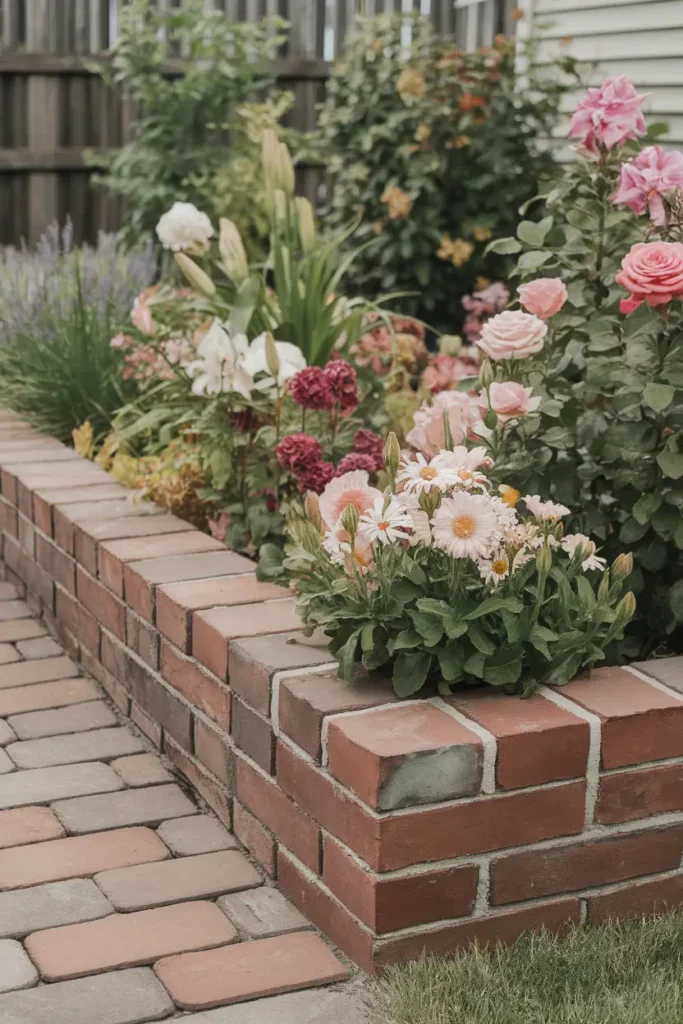
For a classic, timeless look, bricks are a reliable option that has been used in gardens for centuries. You can lay them flat for a simple and subtle design or stack them vertically for added height and dimension.
This edging method not only keeps your plants neatly contained but also adds a structured, polished aesthetic to your garden.
Bricks are weather-resistant and can be arranged in various patterns, giving you flexibility with your design.
2. Gravel Edging
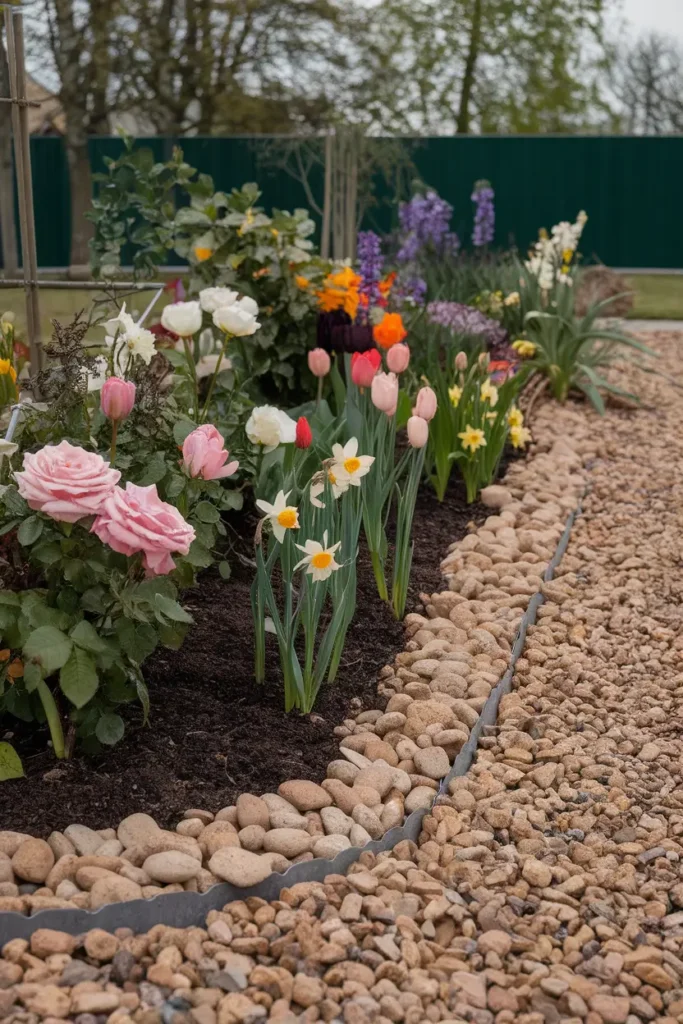
Gravel is a budget-friendly, versatile, and easy-to-install edging option. To create this border, dig a shallow trench, line it with a weed barrier fabric, and fill it with your choice of gravel—crushed stone, pea gravel, or river rock.
Gravel not only maintains clean boundaries in your garden but also improves drainage and reduces weed growth.
It works well with both formal and casual garden designs, making it a practical choice for any space.
3. Metal Edging

If you’re looking to achieve a sleek and contemporary garden design, metal edging is a perfect choice. Made from materials like aluminum or steel, this edging offers clean, sharp lines and flexibility to create curves or angles.
Metal edging is low-maintenance and highly durable, standing up to weather and wear for years.
It’s ideal for those who prefer a minimalist look and want a long-lasting solution that blends seamlessly into modern landscapes.
4. Plastic Edging

For an affordable and straightforward solution, consider plastic edging. Available in rolls or pre-formed sections, plastic edging is lightweight and easy to install, even for beginners.
It’s a practical choice for creating curved or straight borders, and its durability ensures it will last through seasons of wear and tear.
Though it may not be the most stylish option, it’s a reliable choice for gardeners looking for a no-fuss, long-term solution to keep flower beds or pathways in check.
5. Concrete Walls

For a heavy-duty, permanent edging option, concrete walls are a fantastic choice. Concrete offers a professional, polished appearance that works well for formal gardens or retaining walls in sloped landscapes.
These walls can be customized with textures, colors, or even decorative stamps to better suit your garden’s overall aesthetic.
While concrete requires more effort and cost upfront, it provides unmatched durability and stability, making it perfect for large-scale or long-term landscaping projects.
6. Living Hedge Edging

If you prefer a softer, more natural border, low-growing hedges are an excellent choice. Shrubs like boxwood, lavender, or dwarf holly can create lush, green borders that define garden areas while enhancing the overall aesthetic.
Living hedges require regular care, including trimming and watering, but they add texture, fragrance, and a sense of life to your outdoor space. They’re a great option for those looking to achieve a classic, English garden-inspired look.
7. Old Glass Bottles
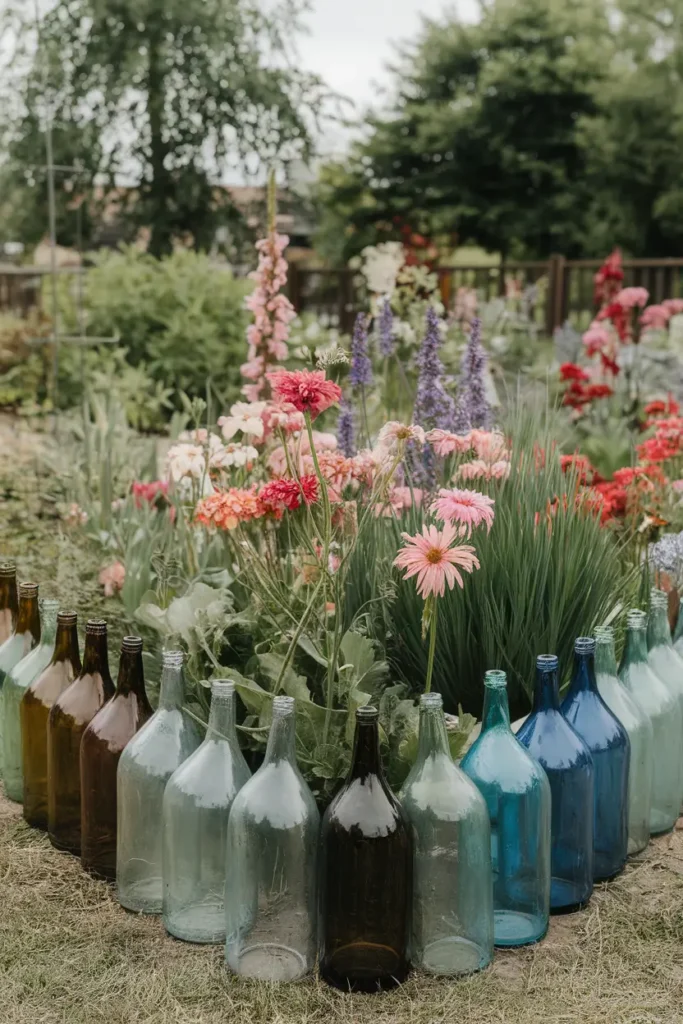
For a creative and eco-friendly option, upcycle old glass bottles by turning them upside down and embedding them in the soil to create a unique garden border.
This sustainable edging choice is not only good for the environment but also adds a whimsical and artistic touch to your garden.
You can mix different colors and shapes of bottles for a vibrant look or stick to one uniform style for a cleaner design. It’s a wonderful way to add personality to your garden while reducing waste.
8. Paver Stones

Paver stones, made from concrete or natural stone, are a sturdy and durable choice for garden edging. They can be laid side by side to create a neat border or stacked for added height and depth.
Pavers work well for defining flower beds, pathways, or driveways, providing both function and style.
Available in a variety of shapes, sizes, and colors, paver stones allow for customization to complement your garden’s theme. Their durability ensures they’ll withstand heavy use and harsh weather.
9. Recycled Rubber Edging

Reduce waste and create clean, modern lines with recycled rubber edging. Made from old tires, this option is eco-friendly, flexible, and incredibly durable. It’s easy to install and safe for mowing close to the edge.
Recycled rubber edging comes in various styles, from simple strips to decorative designs, blending functionality with a contemporary look.
It’s a low-maintenance solution that helps the environment while keeping your landscape tidy and organized.
10. Flagstone Edging

For a rustic or cottage-like feel, flat flagstone pieces stack beautifully as garden borders. The irregular shapes and natural variations in color add character and charm to your outdoor space, making it feel organic and timeless.
Flagstone is also incredibly durable, standing up to weather changes while maintaining its beauty.
11. Stone Pillars
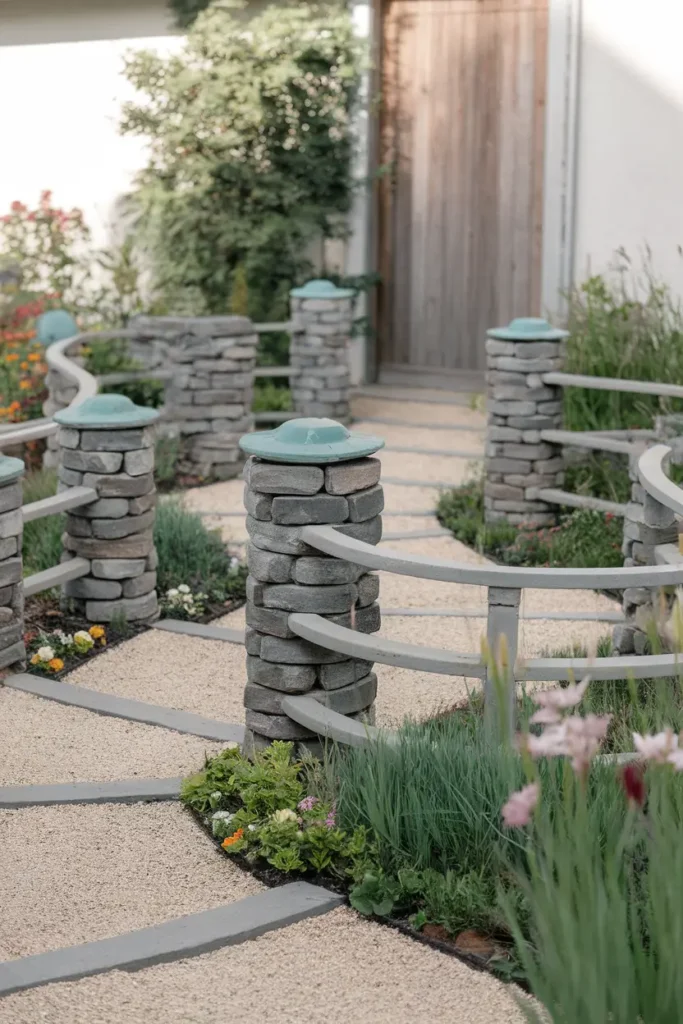
Interlocking stone pillars create a structured and elegant boundary that adds a touch of sophistication to your garden.
While the installation can be labor-intensive and may require professional expertise, the result is a timeless, classic aesthetic that enhances both the function and appearance of your property. Perfect for framing pathways or highlighting specific areas.
12. Weathering Steel Edging

If you’re after an industrial vibe, weathering steel is the go-to material for garden edging. Its naturally developing rusty patina adds warmth, texture, and an earthy tone while maintaining a sleek and contemporary look.
Plus, it’s incredibly durable and resistant to wear, promising a lifetime of use with minimal maintenance.
13. Mixed Plant Borders

For a natural and vibrant edge, create borders using a mix of plants and shrubs. Combine different species to add variety, and layer heights to create depth and interest.
Use colorful foliage and seasonal flowers to ensure your garden remains lively and eye-catching throughout the year.
Mixed plant borders are perfect for blending a structured garden with a more casual, natural look.
14. Wooden Logs

Eucalyptus or other treated wooden logs hammered into the ground create a relaxed, natural vibe that’s both charming and practical.
These logs work particularly well in coastal or tropical gardens, complementing sandy soils and lush greenery. For added durability, make sure the wood is treated to withstand moisture and pests.
15. Terracotta Edging
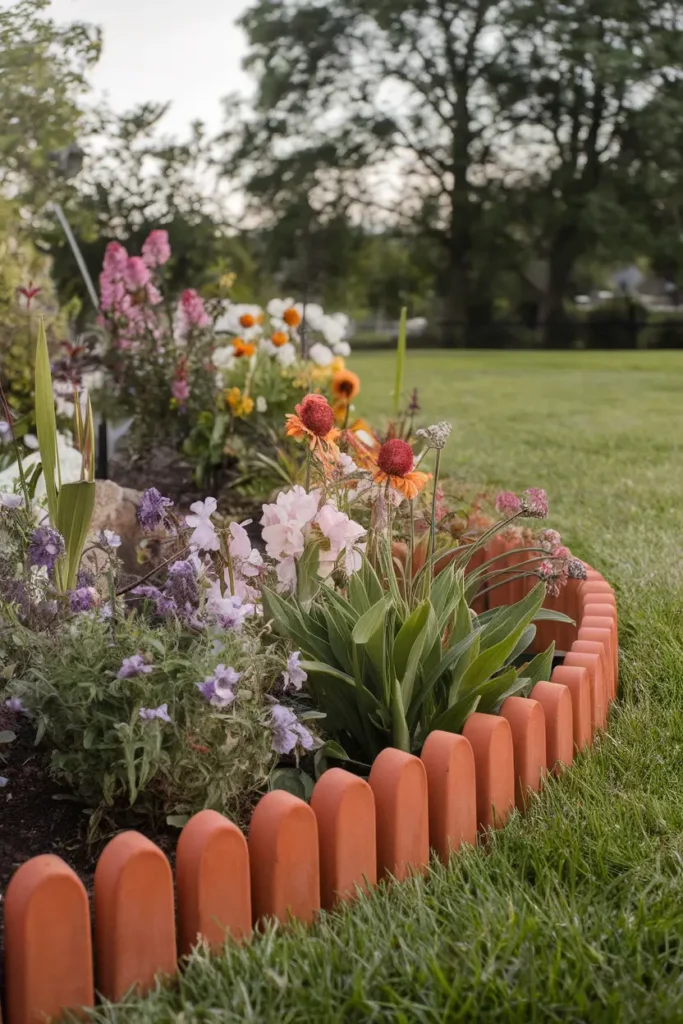
Scalloped terracotta tiles bring old-world charm and warmth to any garden. These earthy, reddish-brown tiles are especially suited for defining pathways or separating vegetable patches from flower beds.
Their curved shapes create a soft, inviting border that blends function with beauty, ideal for Mediterranean-inspired gardens.
16. Raised Flower Bed Edges

Combine functionality and aesthetic appeal by building raised flower beds with wooden or stone frames.
Surrounding trees or zoning off sections of your yard with raised edges helps reduce erosion and creates a polished, organized look.
These raised beds are also easier to maintain, as they provide better soil drainage and reduce weed growth.
17. Bamboo Borders
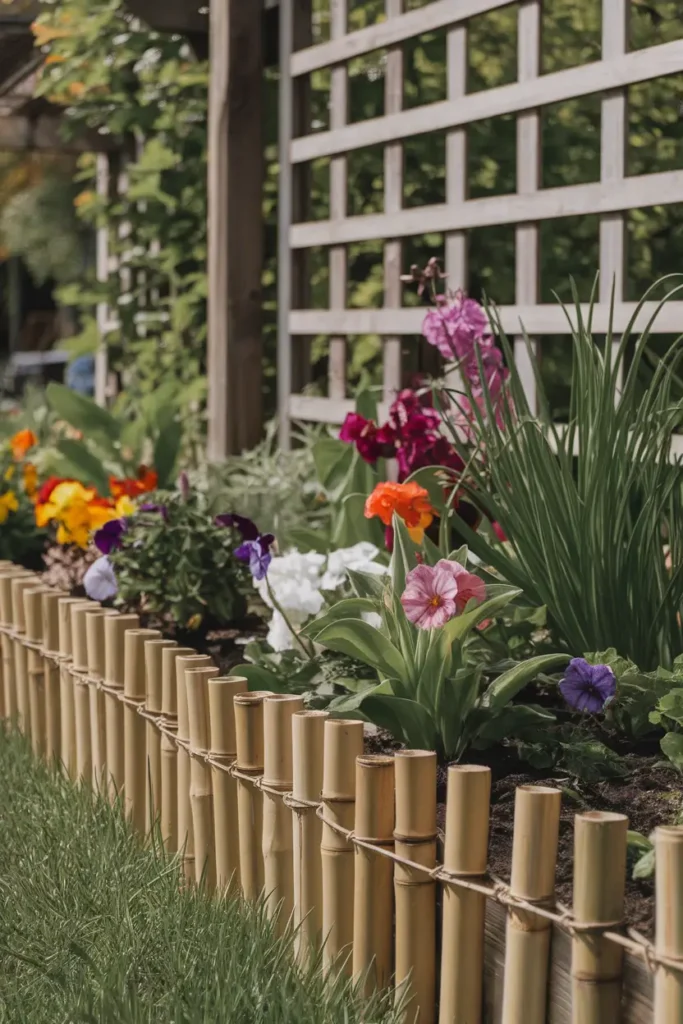
For an Asian-inspired garden, small bamboo poles tied together provide a natural, rustic edge with a serene aesthetic.
They work beautifully alongside tea plants, ferns, and water features, creating a peaceful and harmonious atmosphere. Bamboo is also eco-friendly, making it a sustainable choice for green-minded gardeners.
18. Grass Borders
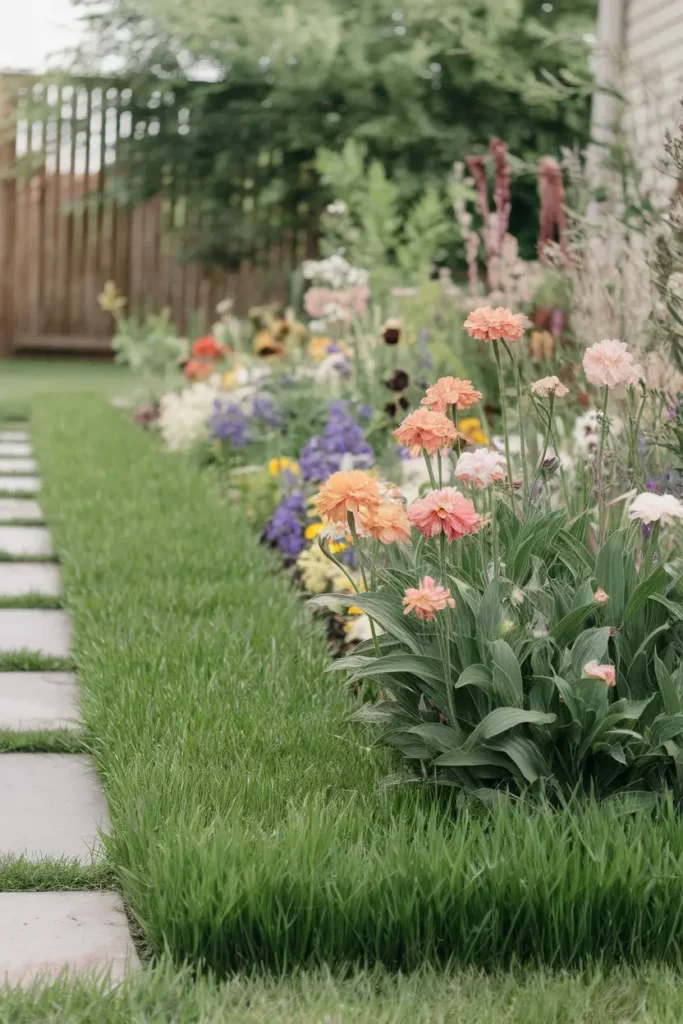
Yes, even grass edges can be purposeful! Mow your lawn carefully to create clean, sharp edges that frame your flower beds or pathways.
This method works well for informal or open gardens, offering a simple yet well-maintained appearance.
Grass borders provide a seamless transition between lawn areas and other garden features.
Factors to Consider When Choosing Edging
Before choosing the best option for your flower bed edging project, take these important factors into account:
- Soil Type and Depth: Some borders, like plastic and metal, require trenching. For harder clay soils, opt for shallow installations, while loose, sandy soils may need deeper edging.
- Weed Protection: Preventing weeds from creeping into your flower bed is key. Consider using barriers like landscape fabric or deep trenching methods under stones and gravel.
- Aesthetic Goals: Match your edging design to the garden’s overall theme. For example, recycled rubber suits modern gardens, while flagstone compliments cottage gardens.
- Budget: Set a realistic budget before starting your project. Gravel, grass edging, or recycled materials like bottles are cost-effective, while stone or stainless steel may be pricier but more durable.
FAQs
What material is the most durable for edging?
Materials like concrete, weathering steel, and paver stones are extremely durable and can last decades with minimal upkeep.
Can DIYers install all types of edging?
While many edging types, like gravel or plastic, are simple to install, others, such as poured concrete or stone pillars, may require professional help.
How do you prevent weeds from growing into my flower bed?
Use landscape fabric under stones or gravel and ensure tight placement to limit weed growth. Regular maintenance with sprays or hand-pulling is also necessary.
Should you choose edging based solely on aesthetics?
Not entirely. Consider both functionality and the overall style of your garden. The best edging strikes a balance between form and function.
Conclusion
Flower bed edging is the final touch that elevates your garden into a striking, organized space. Whether using eco-friendly options like recycled rubber, natural elements like stone and wood, or bold options like weathering steel, edging instantly enhances curb appeal and practicality.
Redefine your gardening goals, choose materials that align with your budget and style, and ensure your flower beds bloom beautifully for years to come. Now, it’s time to roll up your sleeves and bring your edging dreams to life!

